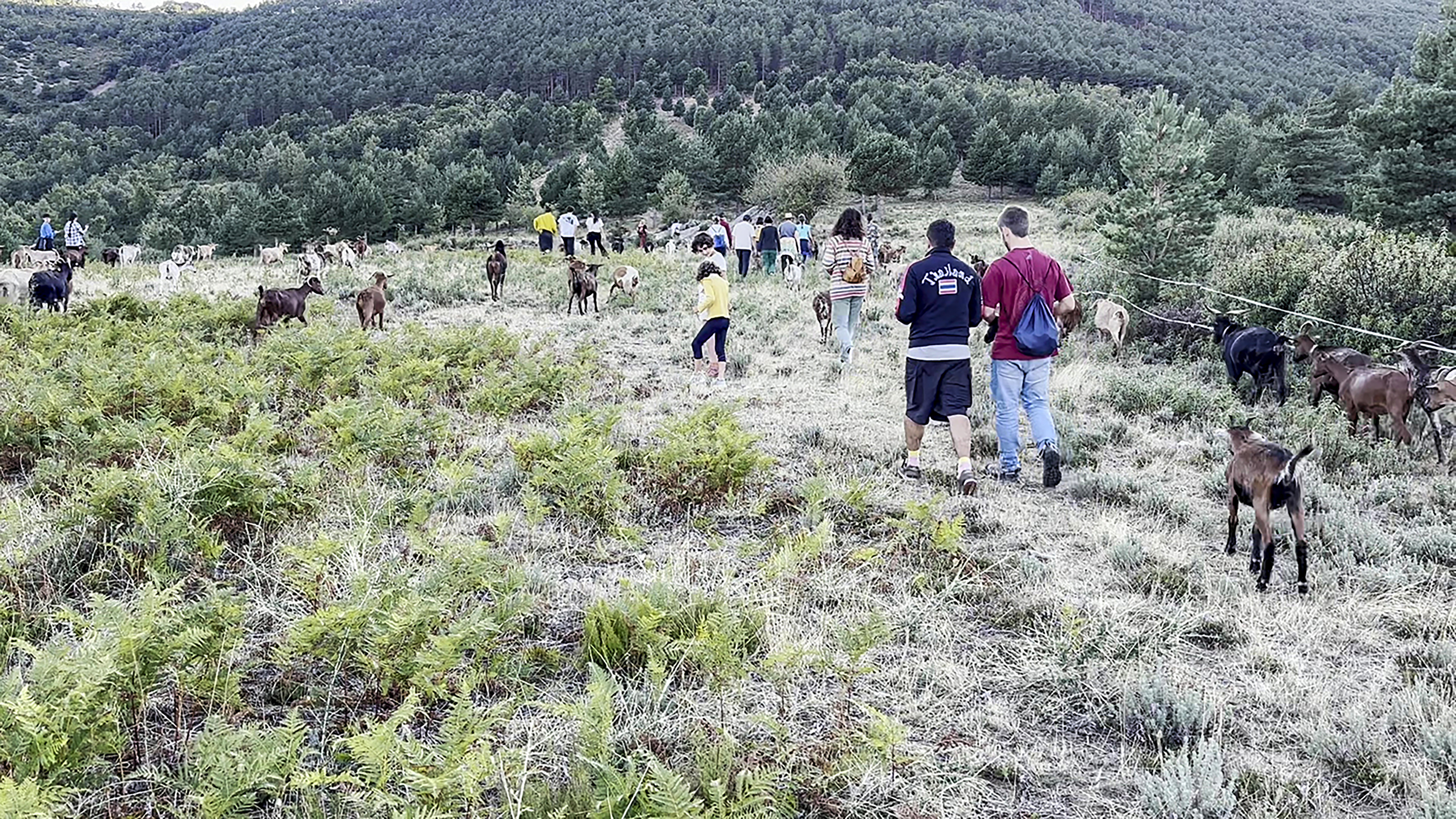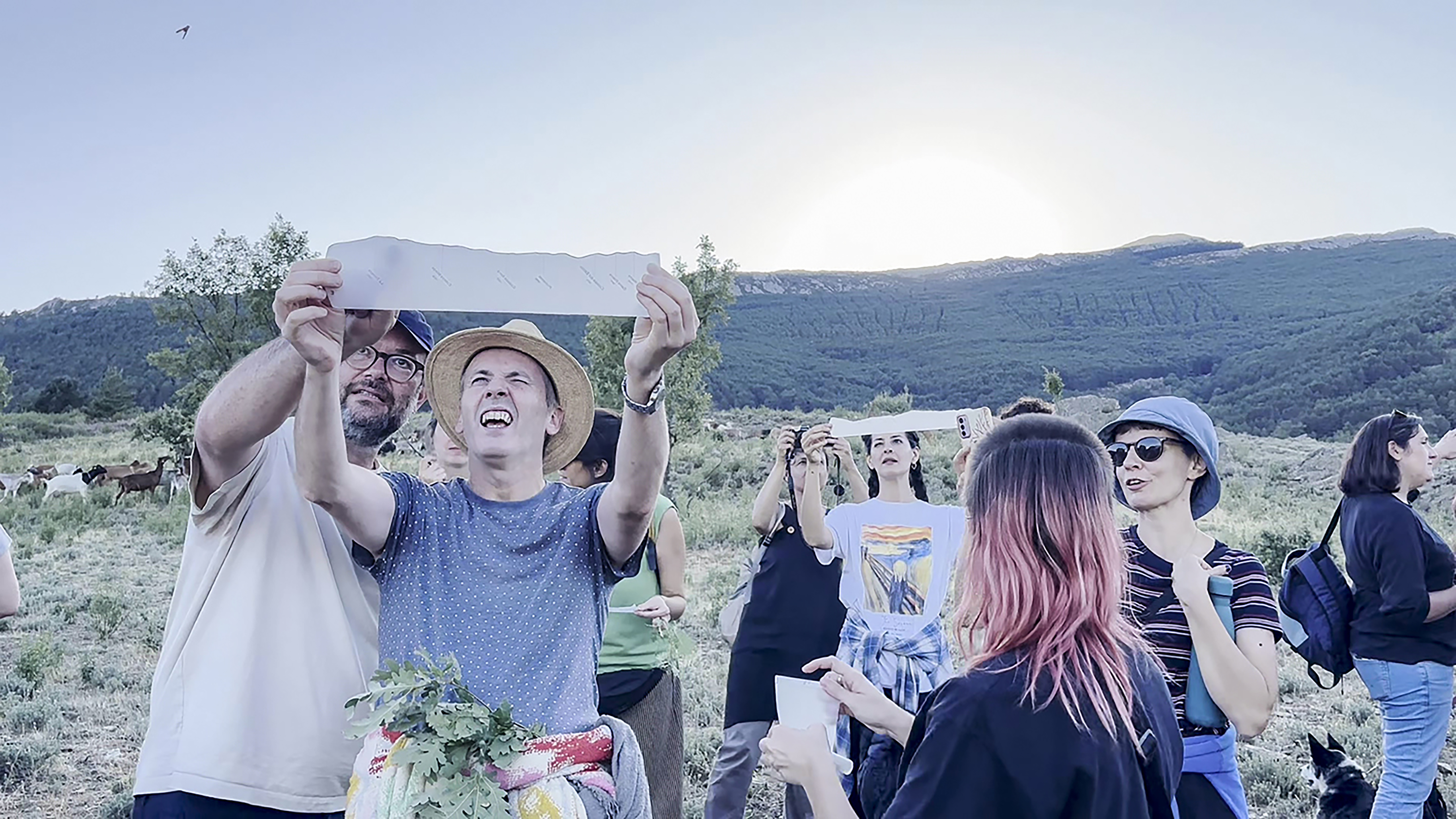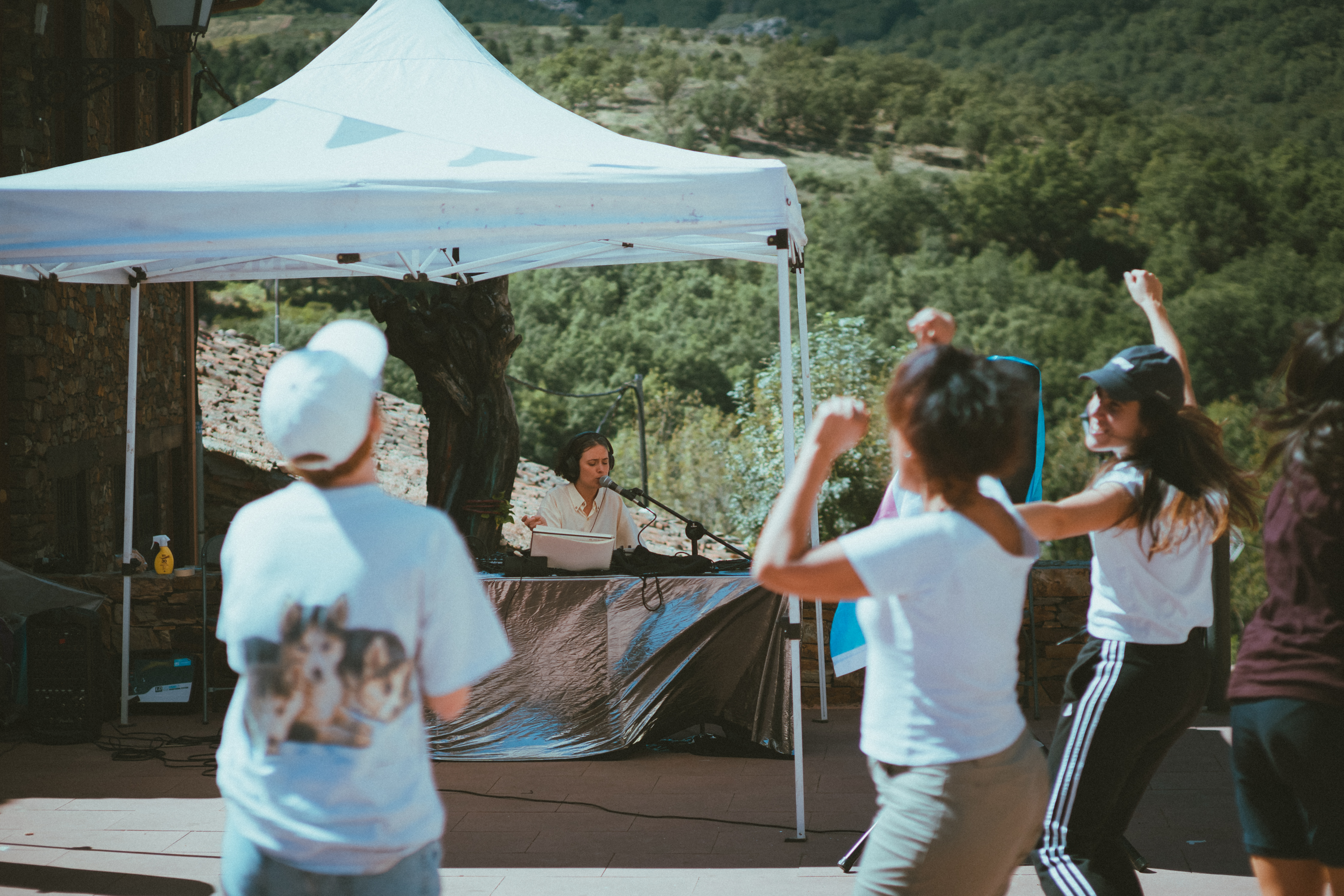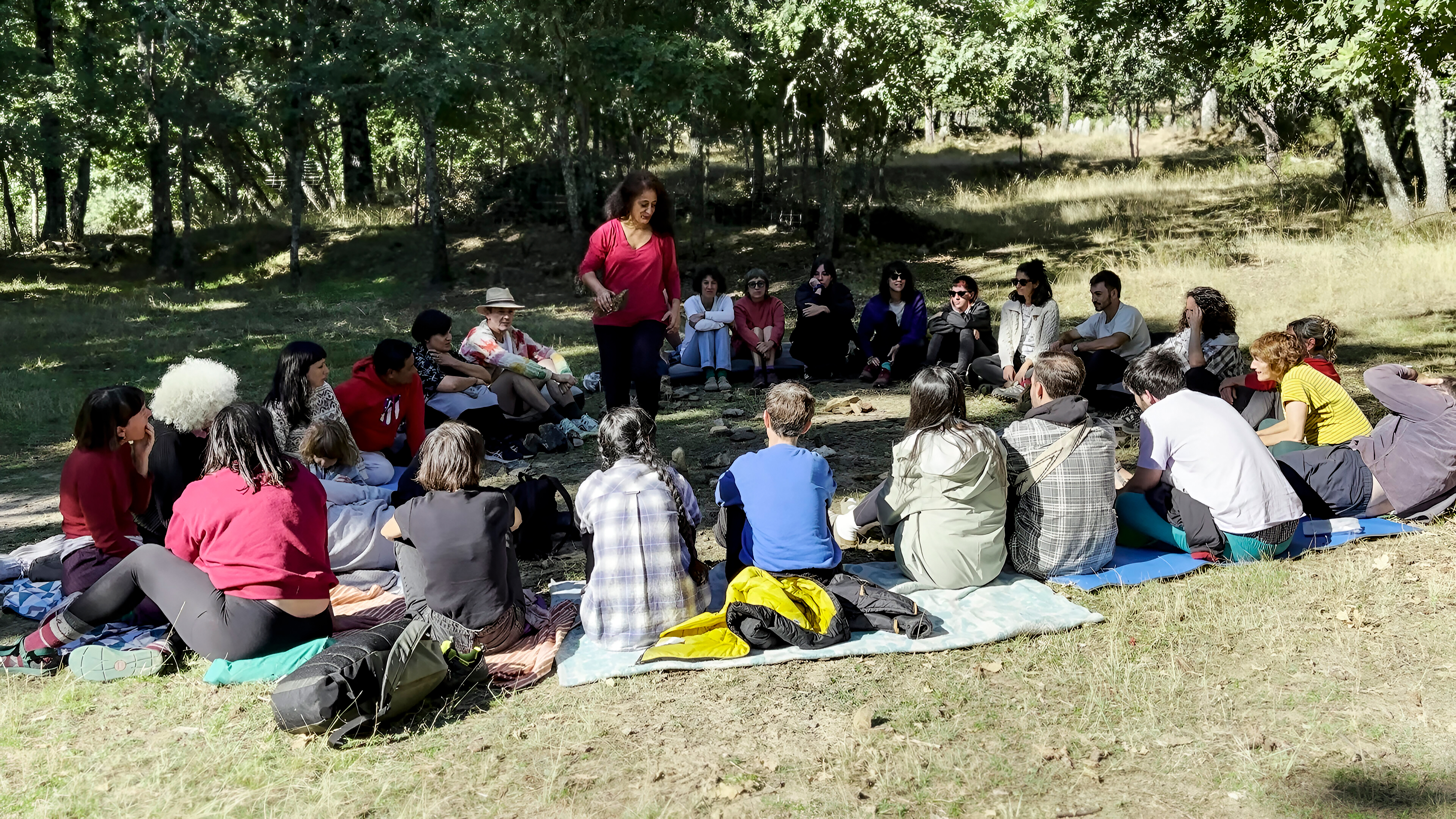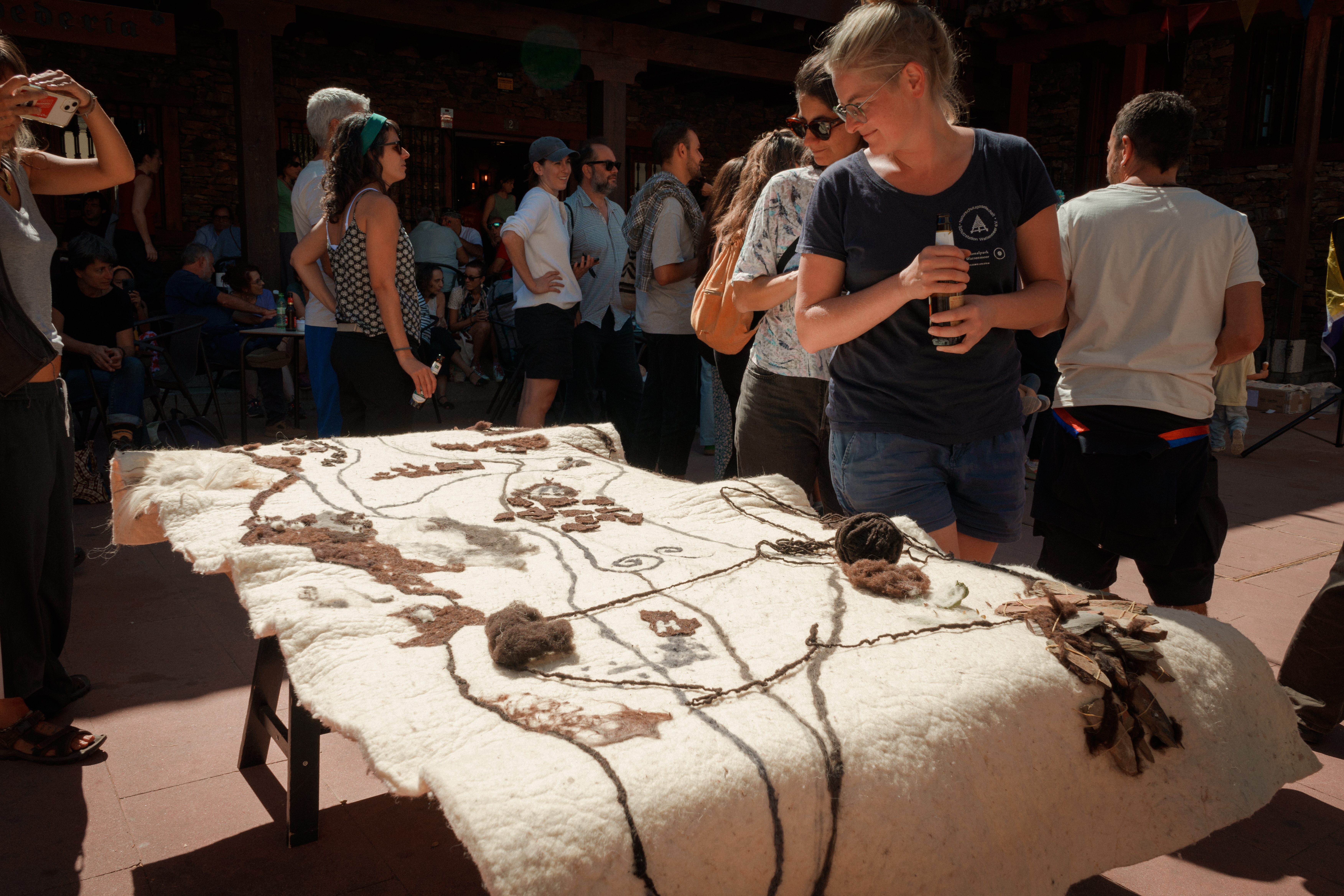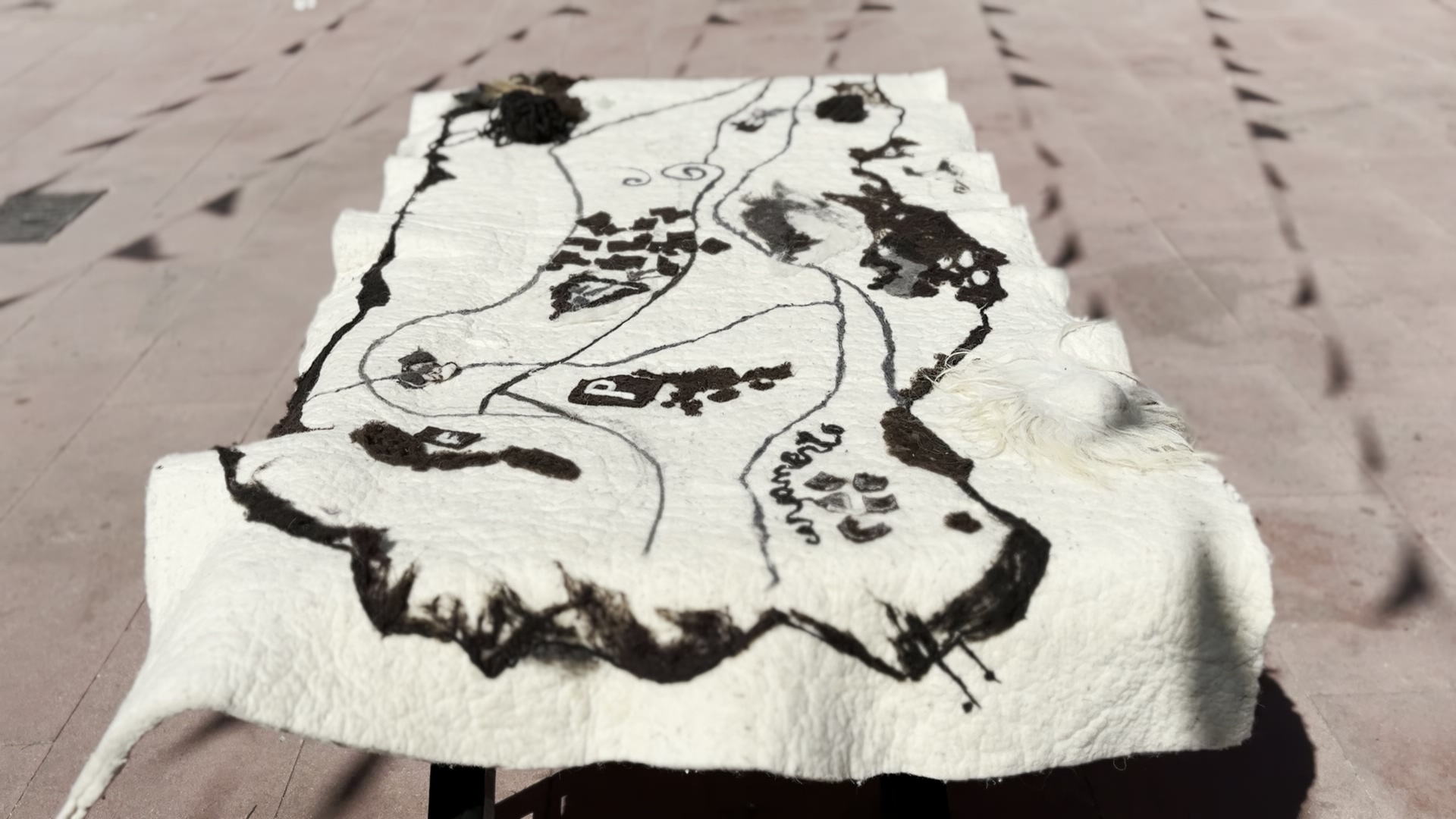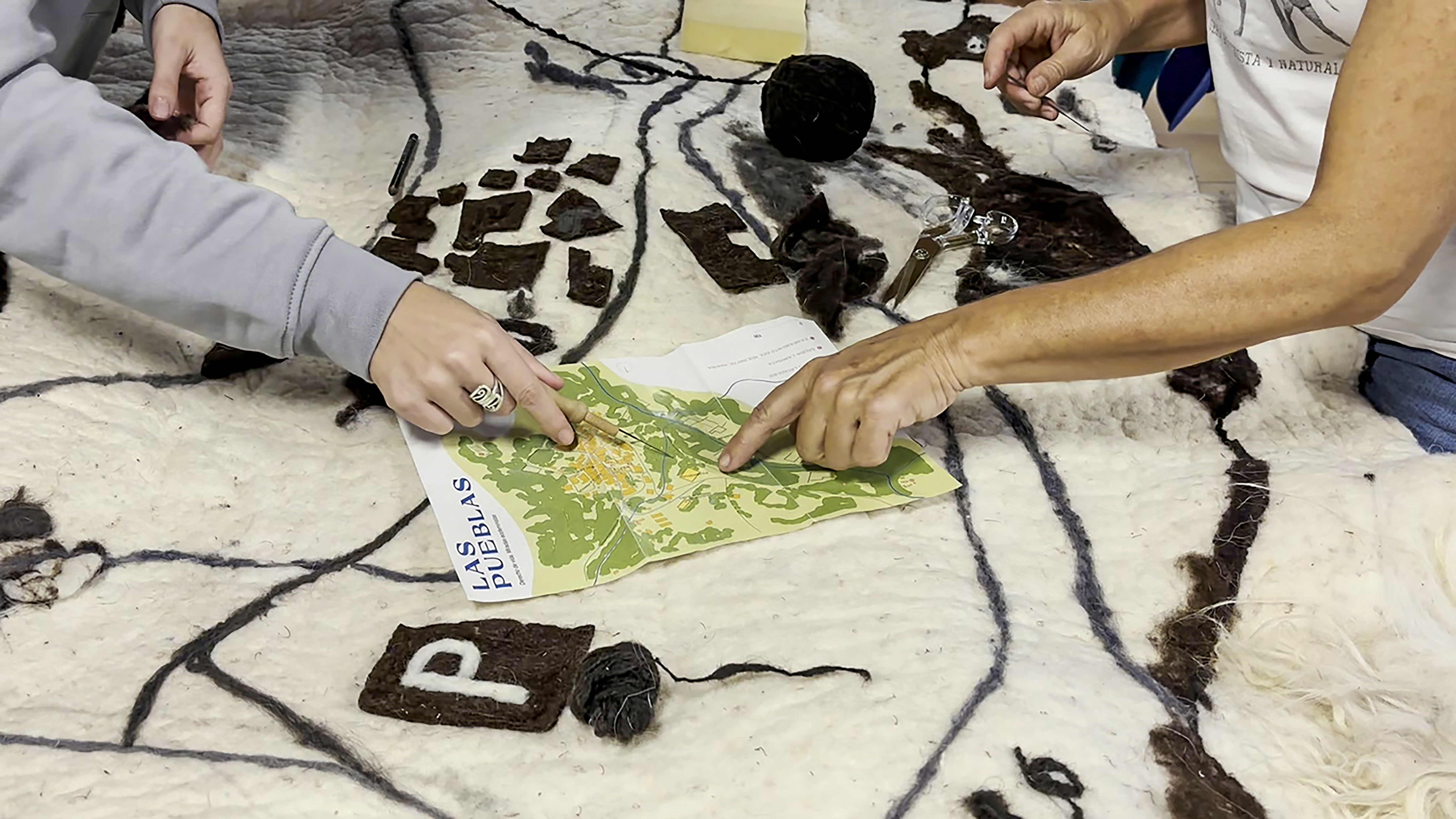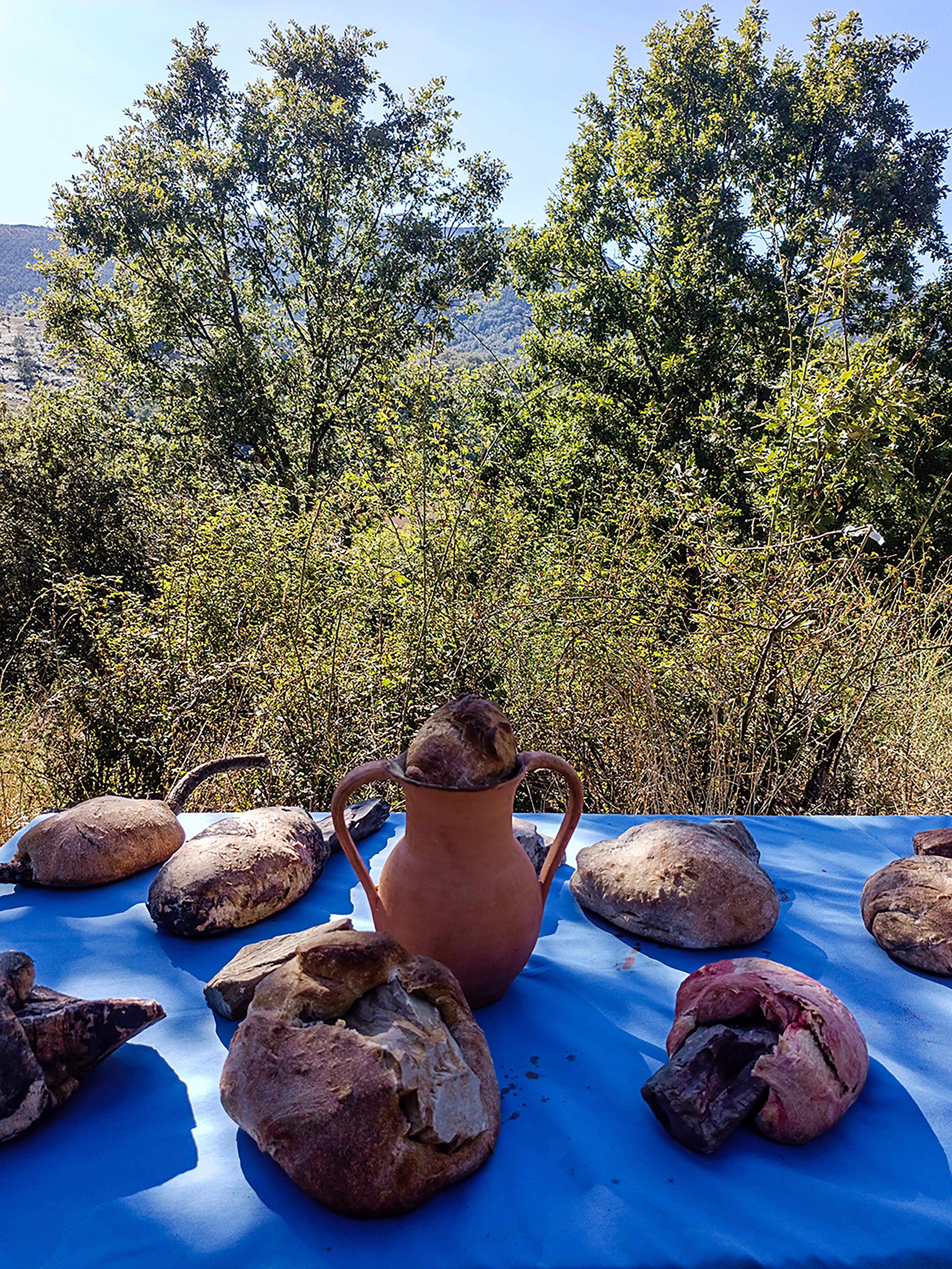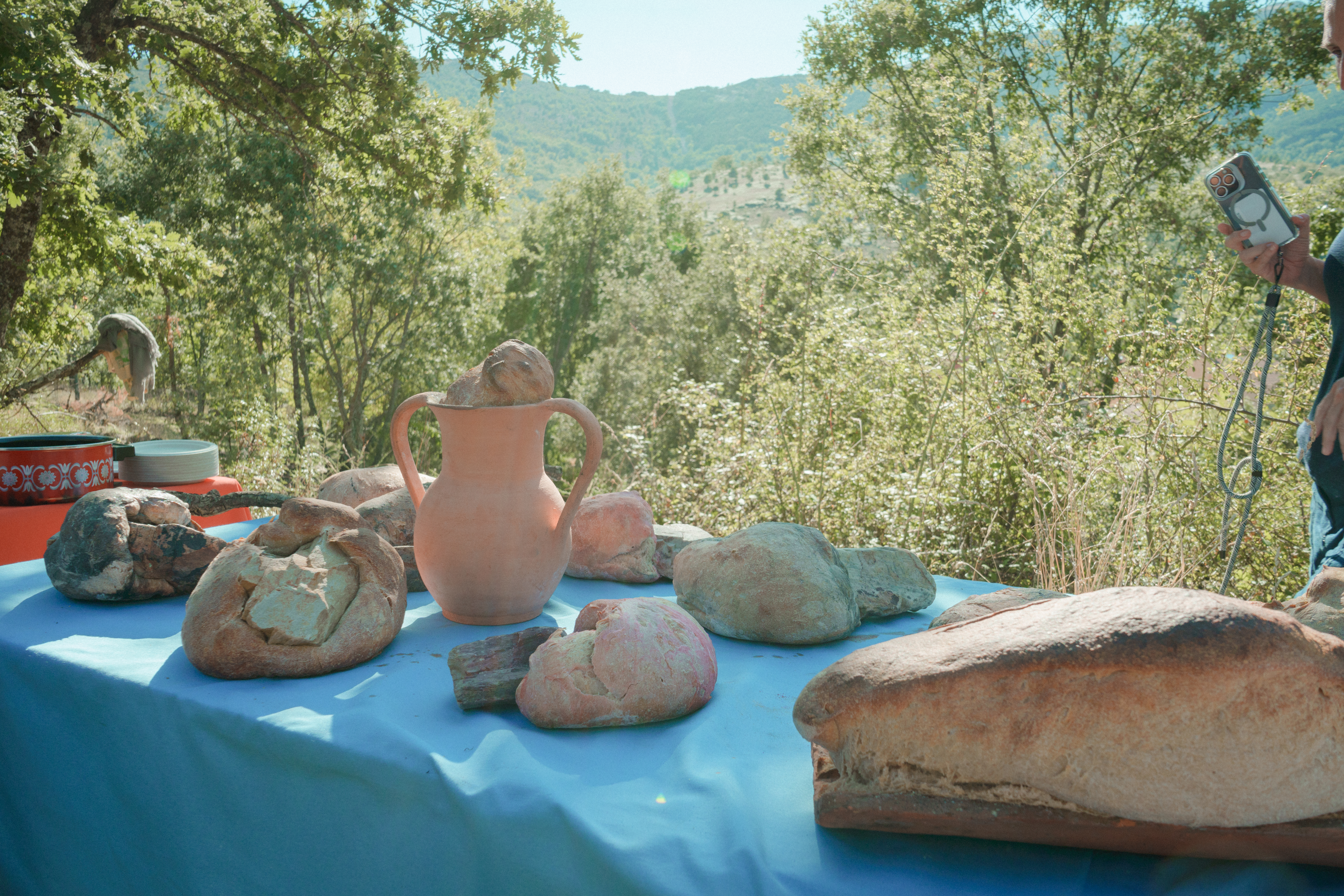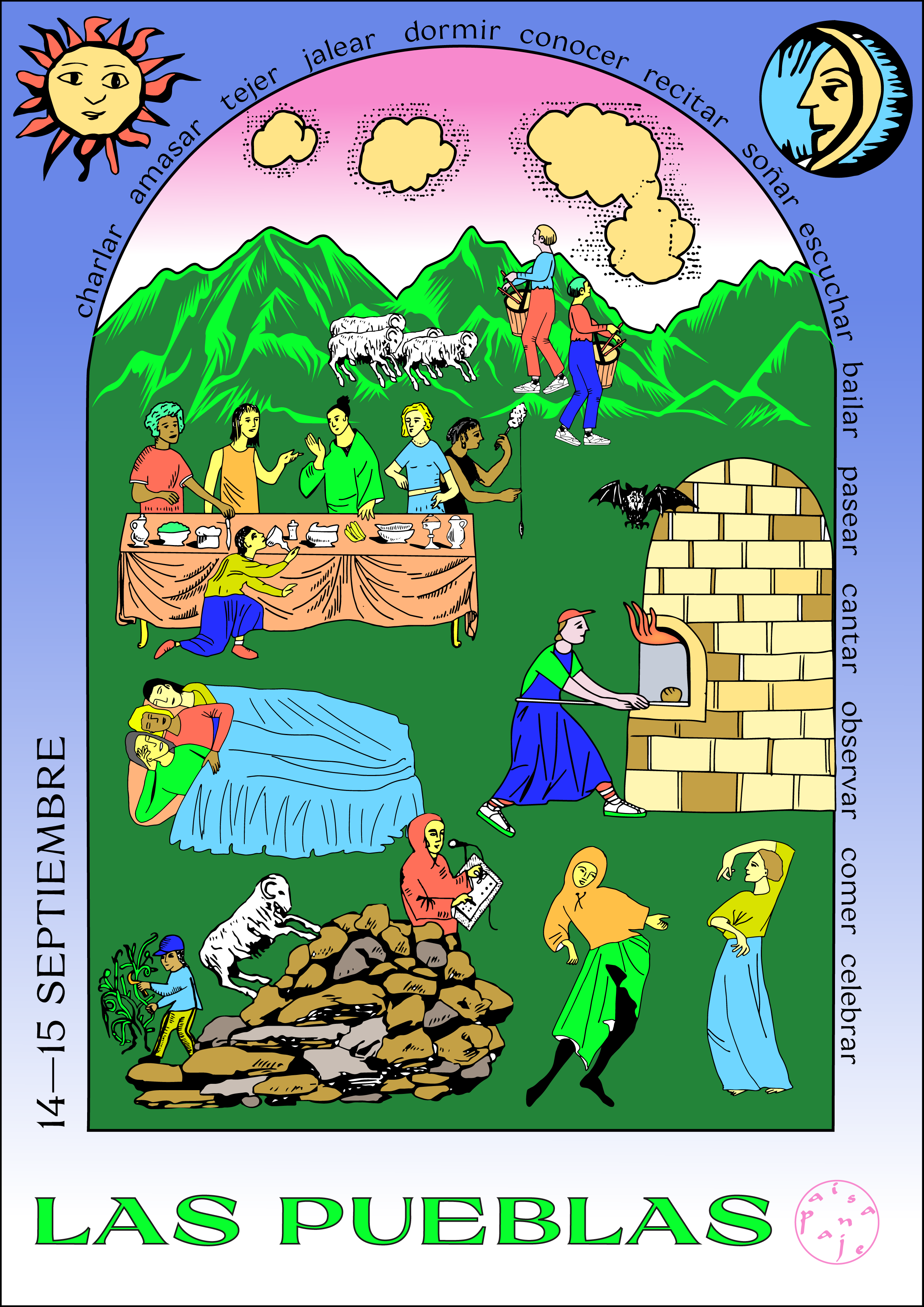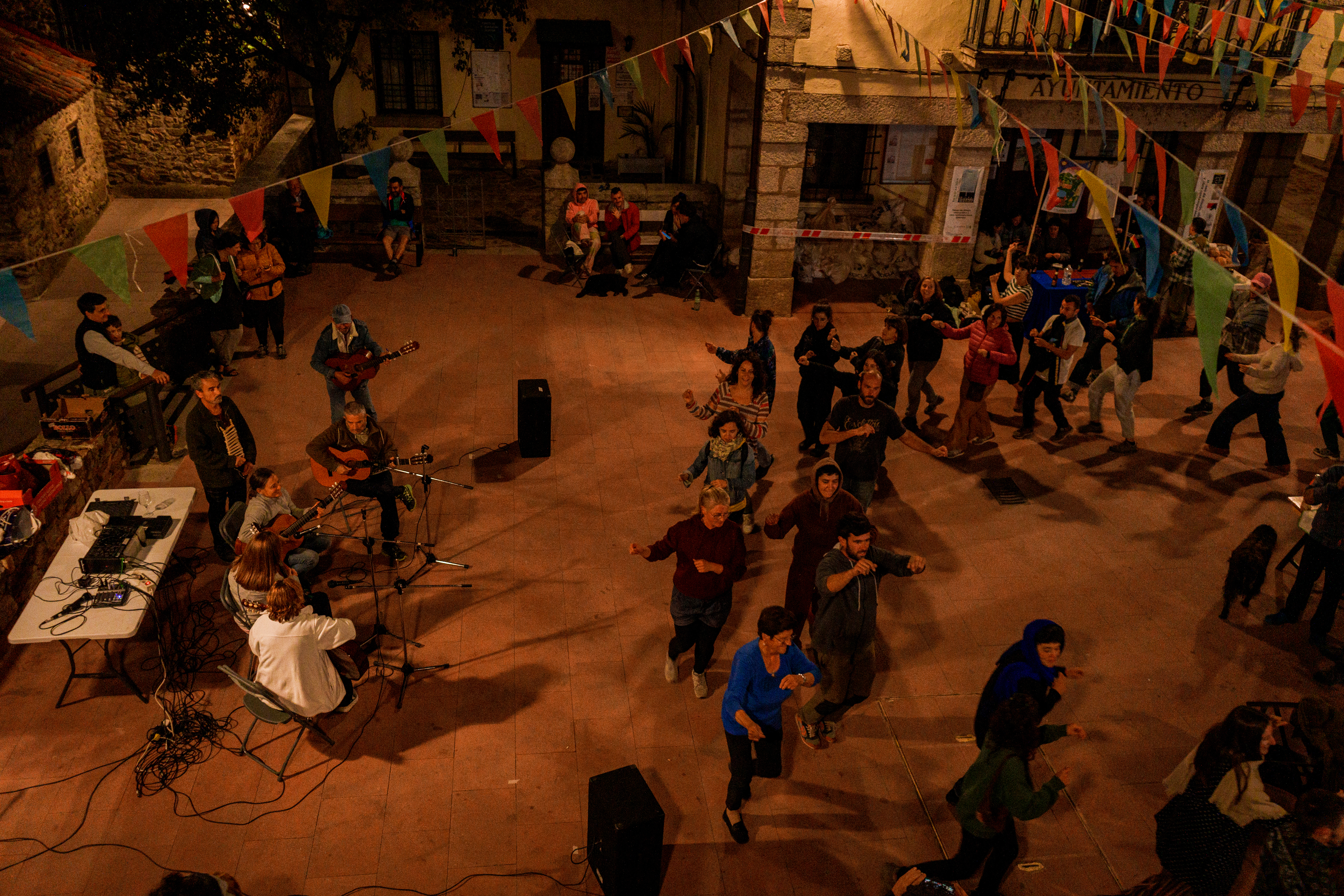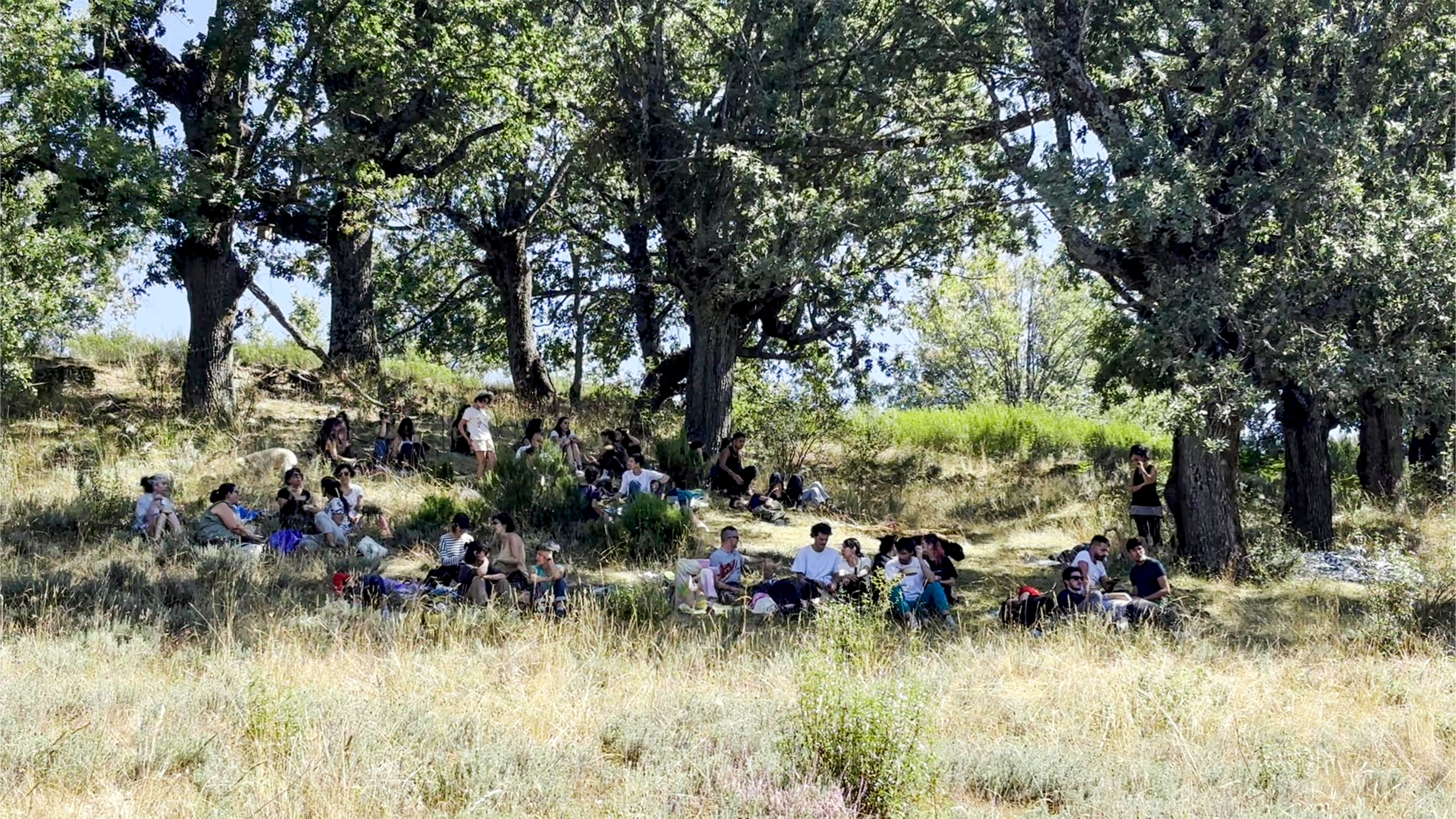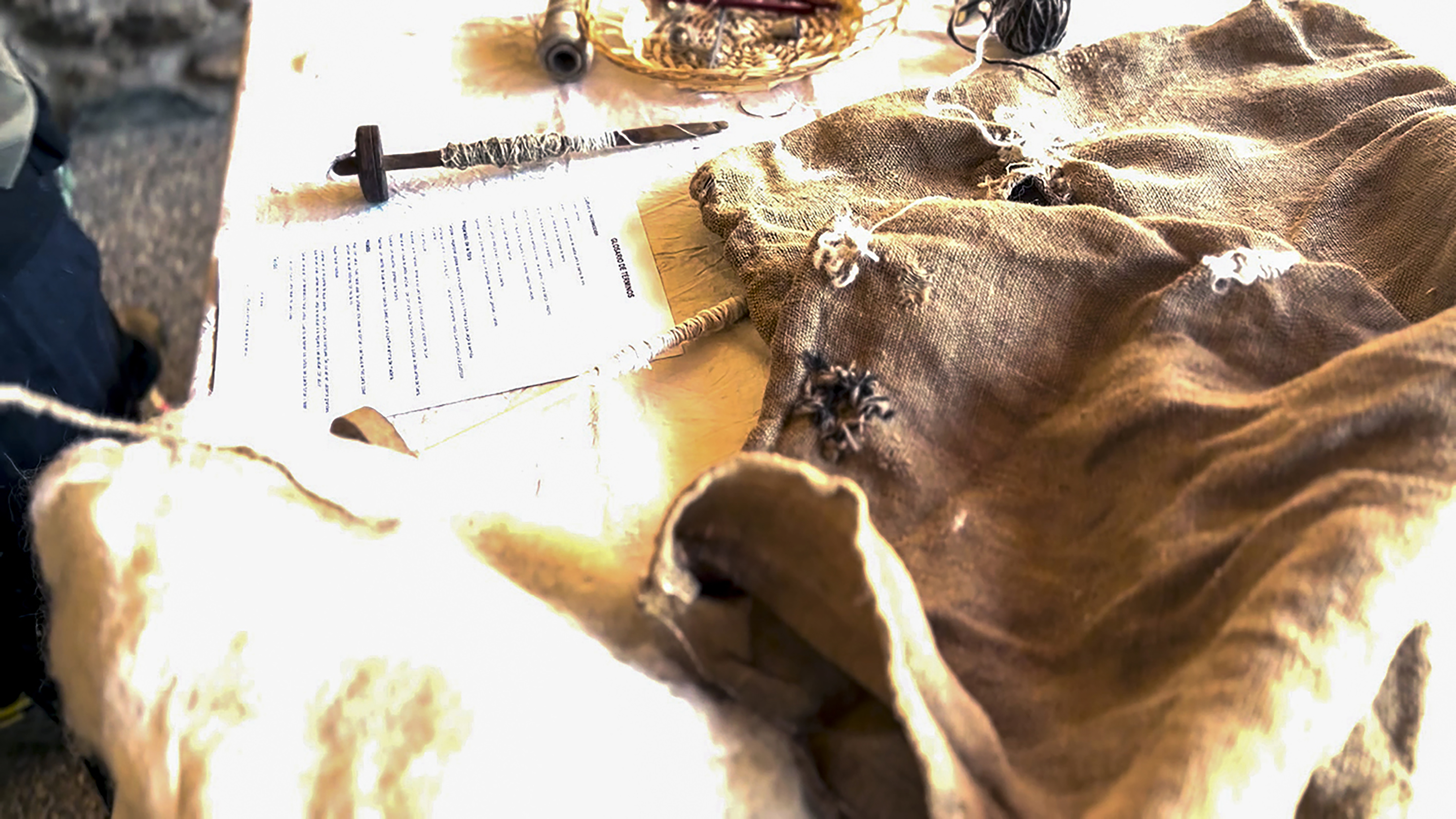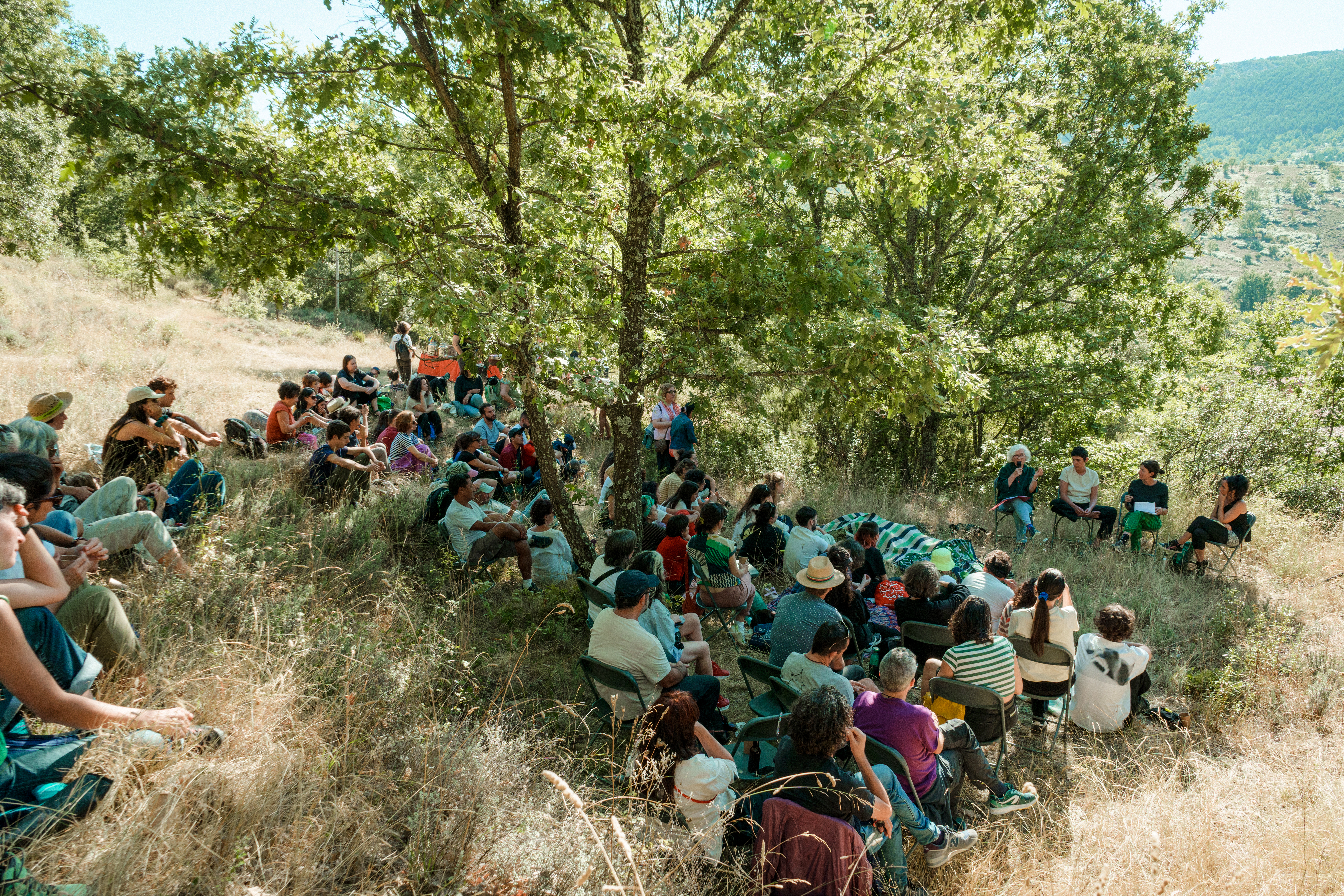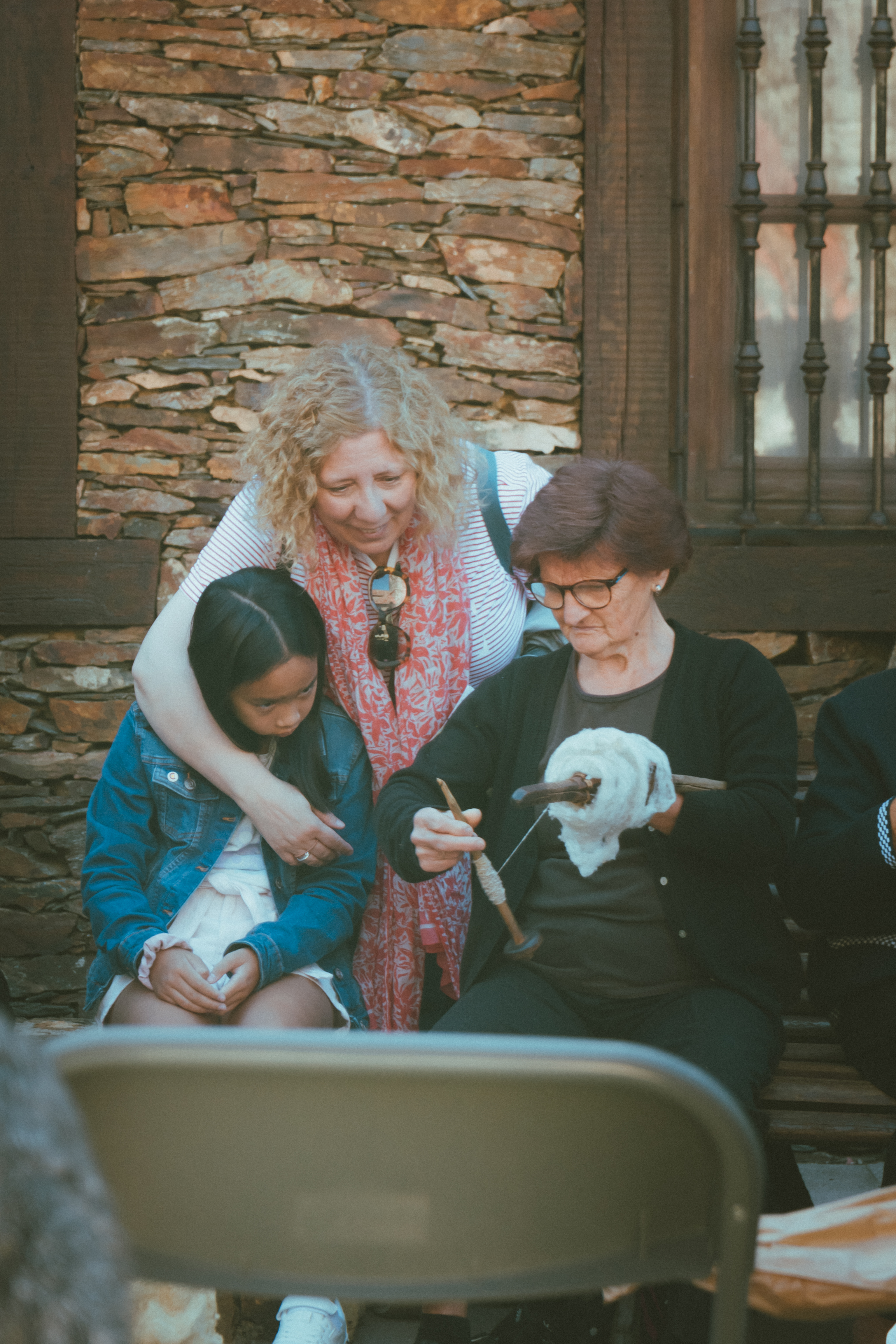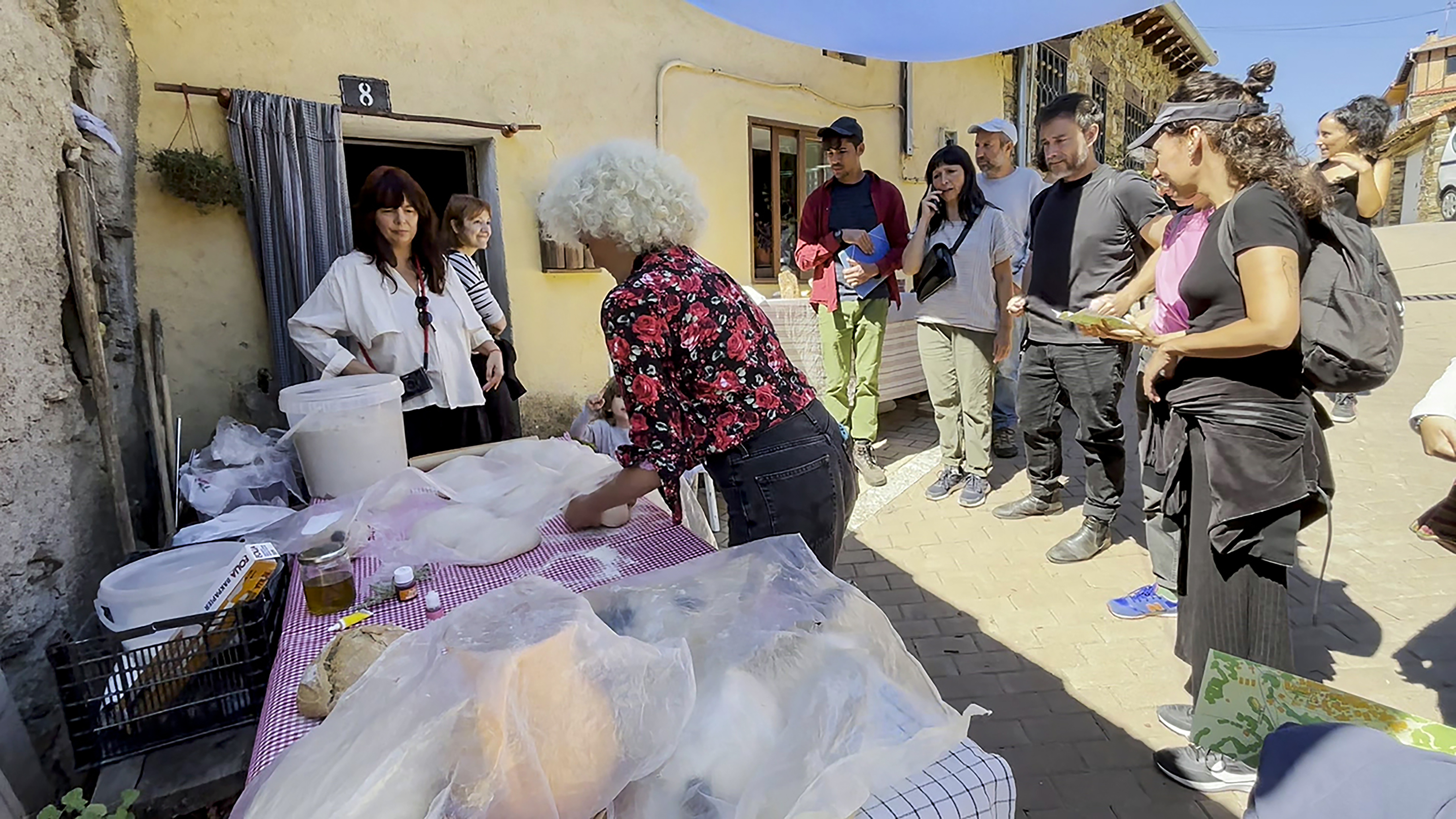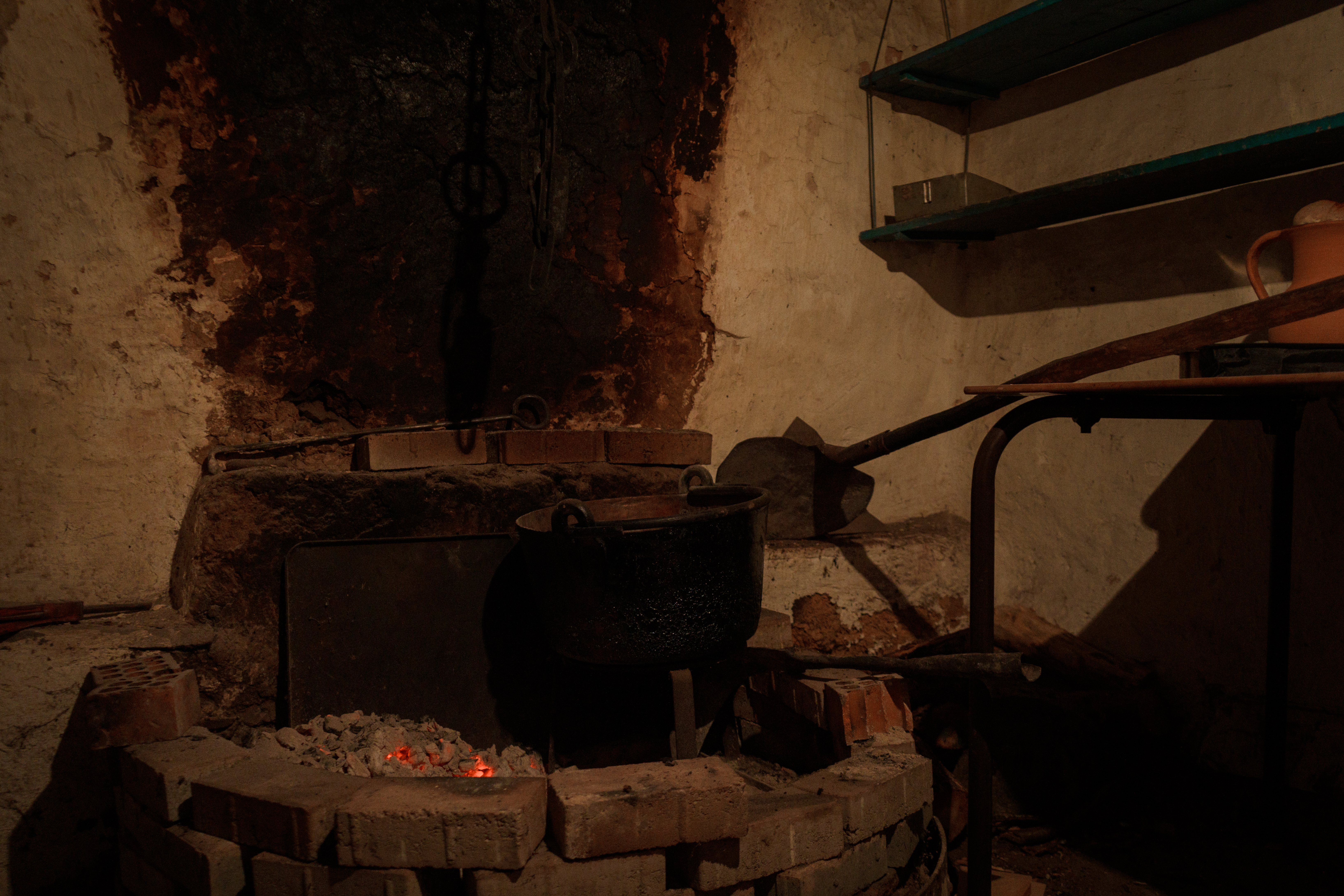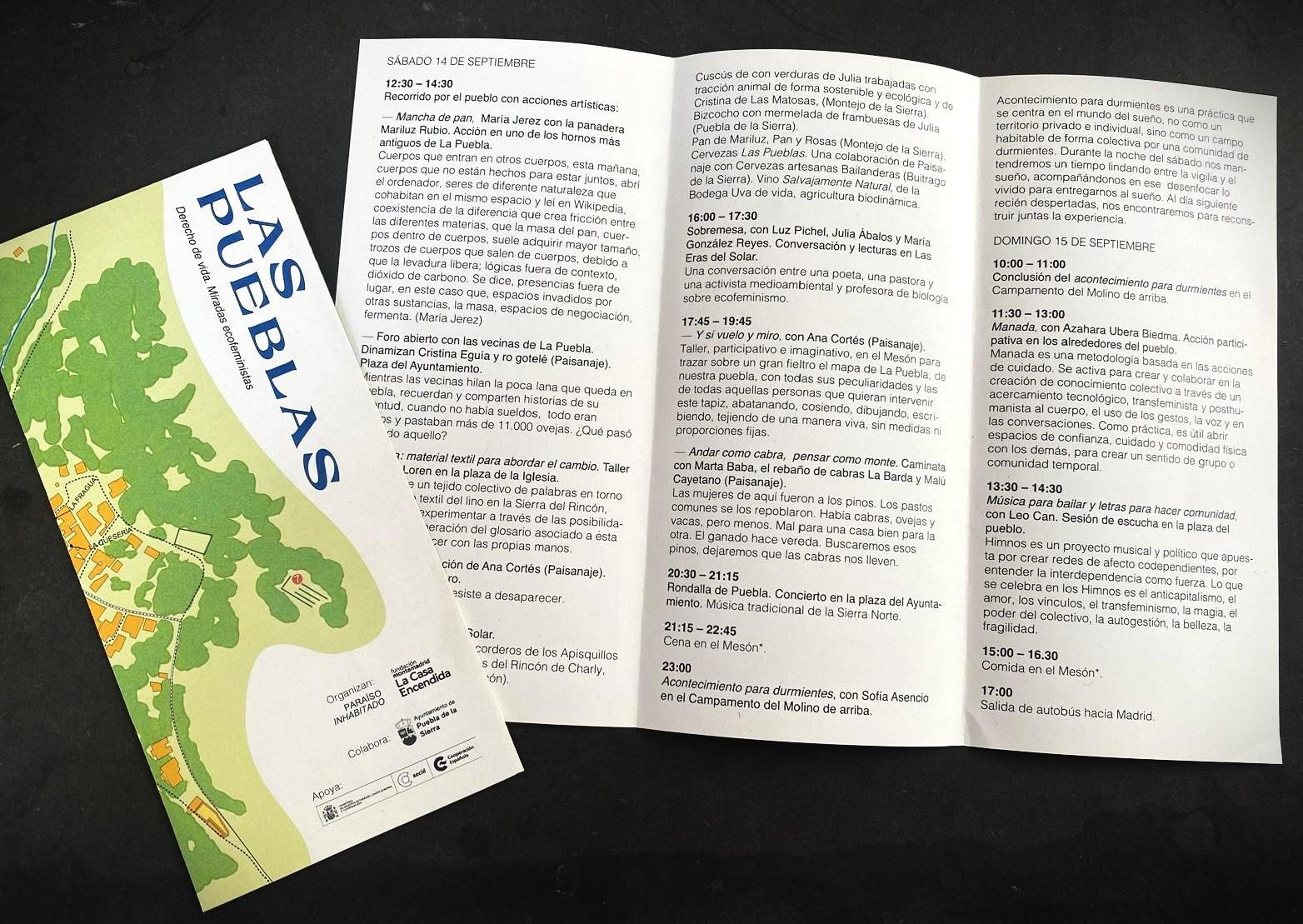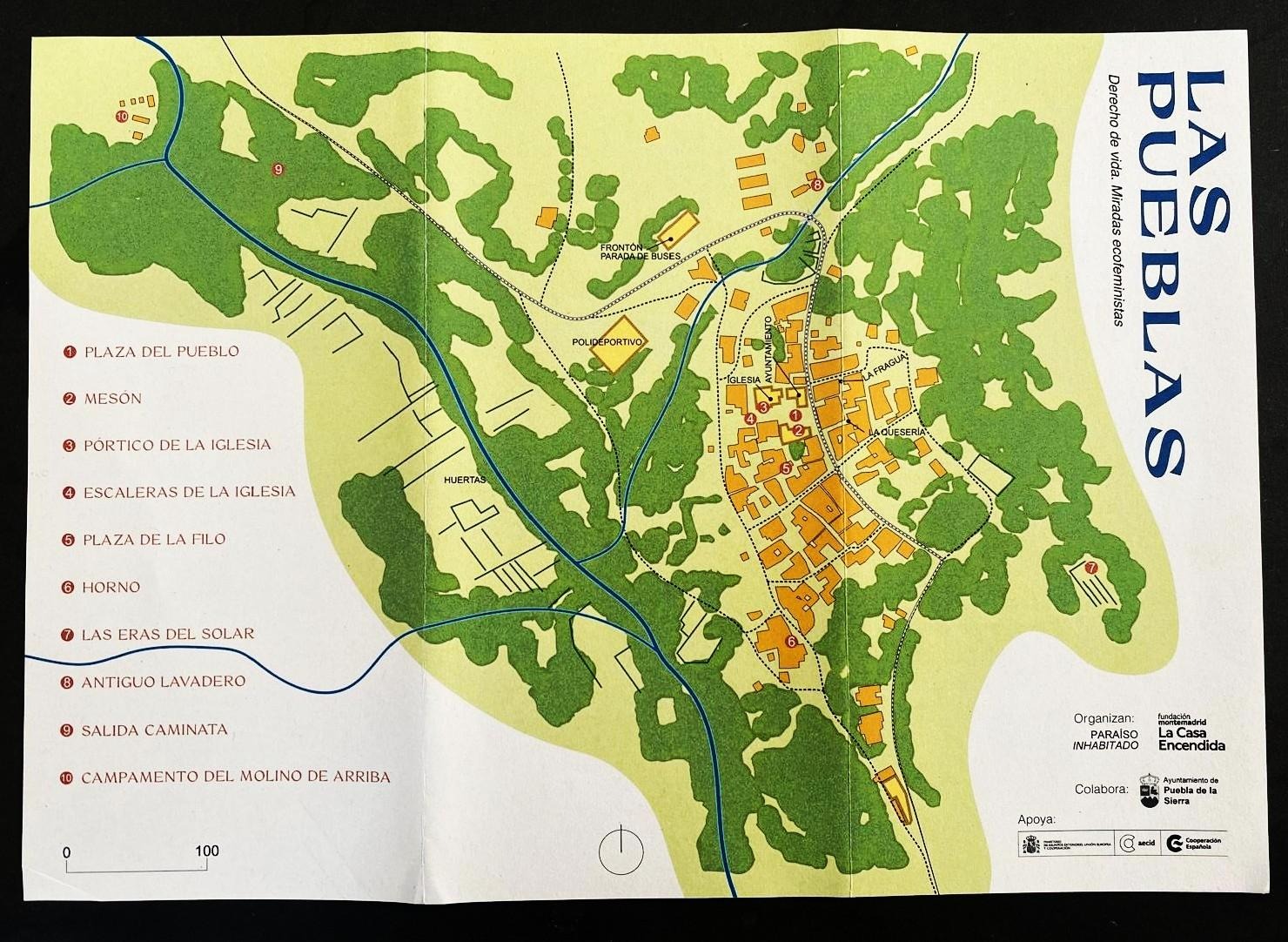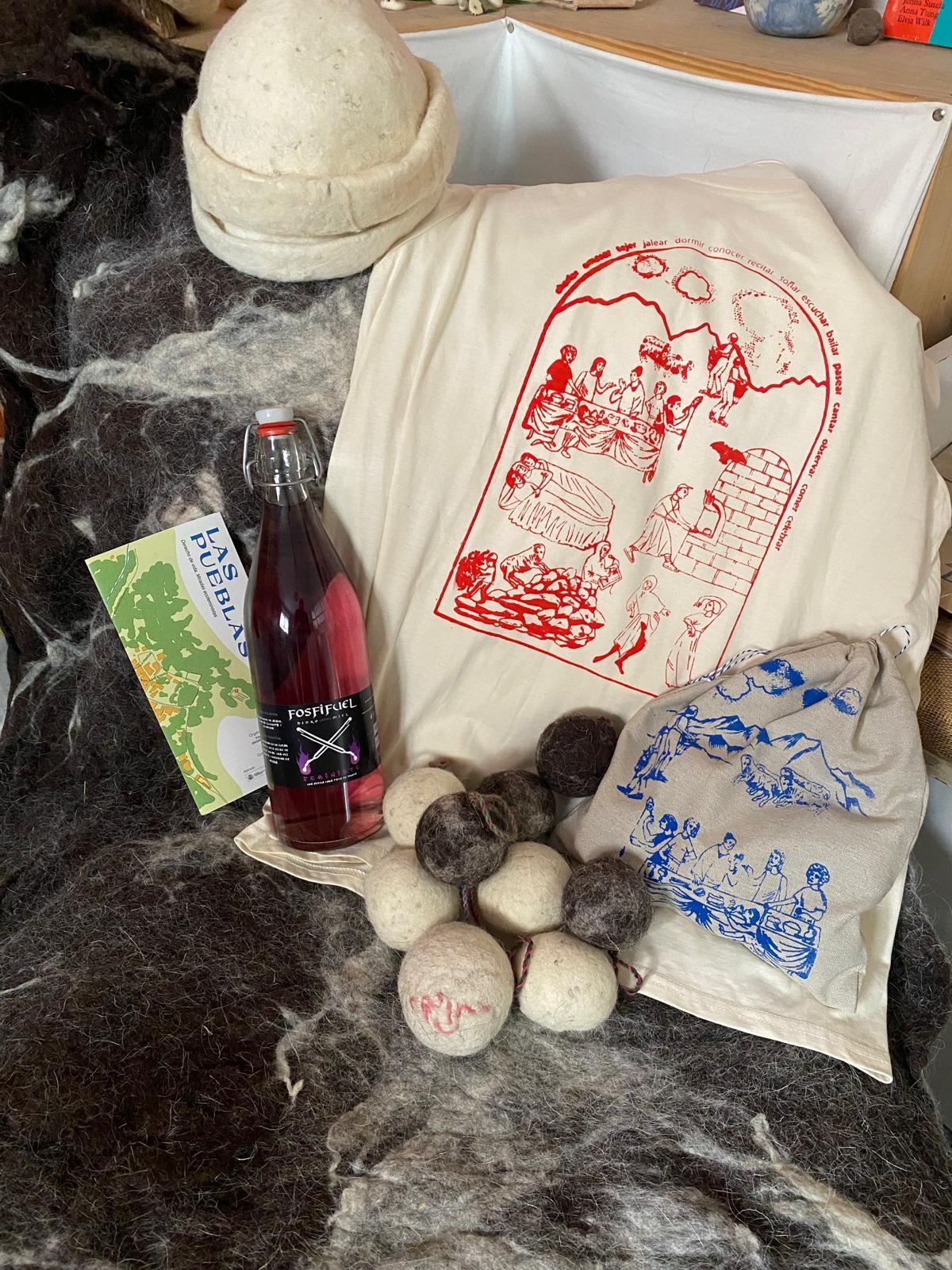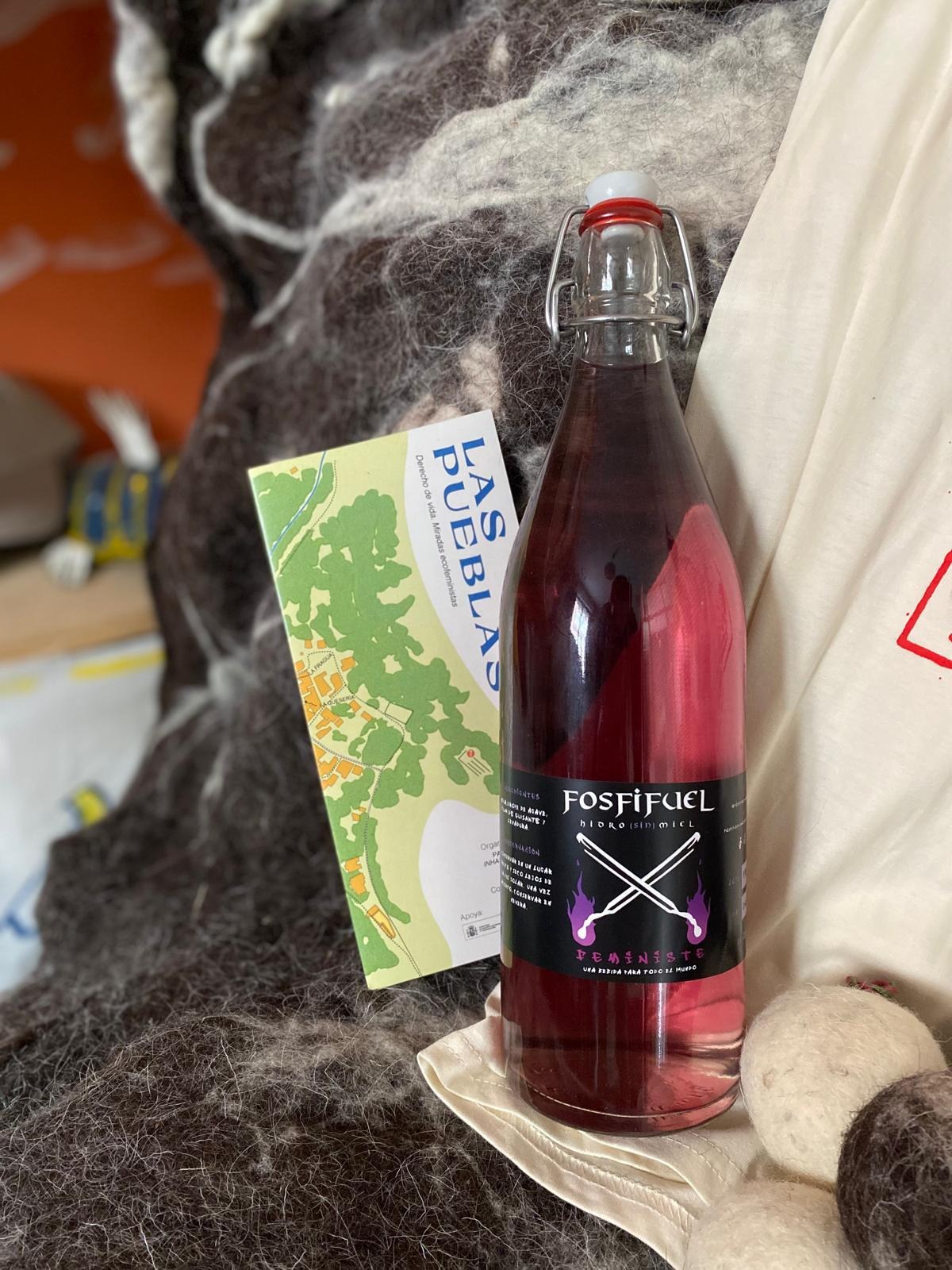Shaping a circular industrial ecosystem and supporting life-cycle thinking
Las Pueblas
Las Pueblas - A Project on Ecofeminism
Las Pueblas brings together shepherds, artists, wool-workers and friends in a celebration centered around ecofeminism. The celebration took place in Puebla de la Sierra, a tiny village located just outside of Madrid that defines norms and rural stereotypes. A hotbed of feminine engagement, Paisanaje inhabited the village for a weekend to sing, dance, cook, walk through the mountains, engage in dialogue with the mountain and the plaza, and to discuss concepts of ecology, feminism and territory.
Spain
Local
Puebla de la Sierra
It addresses urban-rural linkages
It refers to other types of transformations (soft investment)
Yes
2024-09-15
No
No
No
As a representative of an organisation
Puebla de la Sierra is a small remote village in the Sierra Norte, just 100km outside of Madrid where fewer than 150 inhabitants still live. Home to the shepherding collective Los Apisquillos and their flock of sheep that annually descend the mountains, cross valleys and pass through towns and cities in the ancient transhumance process, searching for food and warmer weather during the cold months.
We have been working for years in Puebla–it is a feminine territory, an enclave in need of visibility. In the framework of España Vacía (Empty Spain), rural areas are at risk, a risk which grows greater everyday as our dependence on large scale industrialized production grows. Macro-farms are replacing small-scale family run farms, and local produce and land are in danger of becoming a thing of the past. Paisanaje, in collaboration with those from Puebla, aim to create more desirable futures in which sustainable practices, local products and traditional knowledge are not only maintained, but desired. A future in which people from urban spaces can feel at home in rural ones, and where all forms of life can coexist peacefully and symbiotically in the city.
This past summer, through an alliance of Paisanaje and the woman of Puebla de la Sierra, we devised a project surrounding ecofeminism. When we think of rural environments, we think of a man’s world; of worn, bearded faces, strong arms and rough hands. In Puebla, the posts traditionally held by men, builders, gardeners, bakers, shepherds, etc. are all occupied by women. We therefore had to ask ourselves: where are these women's faces and hands in the collective imagination? What space do their stories have? What value is given to their traditions?
Las Pueblas confronts those questions and celebrates these women and the inhabitants of the village, both living and nonliving, in an impactful and embodied practice of community and sustainability.
We have been working for years in Puebla–it is a feminine territory, an enclave in need of visibility. In the framework of España Vacía (Empty Spain), rural areas are at risk, a risk which grows greater everyday as our dependence on large scale industrialized production grows. Macro-farms are replacing small-scale family run farms, and local produce and land are in danger of becoming a thing of the past. Paisanaje, in collaboration with those from Puebla, aim to create more desirable futures in which sustainable practices, local products and traditional knowledge are not only maintained, but desired. A future in which people from urban spaces can feel at home in rural ones, and where all forms of life can coexist peacefully and symbiotically in the city.
This past summer, through an alliance of Paisanaje and the woman of Puebla de la Sierra, we devised a project surrounding ecofeminism. When we think of rural environments, we think of a man’s world; of worn, bearded faces, strong arms and rough hands. In Puebla, the posts traditionally held by men, builders, gardeners, bakers, shepherds, etc. are all occupied by women. We therefore had to ask ourselves: where are these women's faces and hands in the collective imagination? What space do their stories have? What value is given to their traditions?
Las Pueblas confronts those questions and celebrates these women and the inhabitants of the village, both living and nonliving, in an impactful and embodied practice of community and sustainability.
Ecofeminism
Communal luxury and unity
Sustainability and awareness
Rural-urban linkage
Local patronage
Las Pueblas is an artful celebration of sustainability, blending ecological and cultural resilience. In a village of just 150 inhabitants, largely led by women occupying traditionally male roles like shepherding and wool production, sustainability is woven into the community’s very fabric. The feminine name of the village itself evokes a narrative of reclamation and strength, where gender and ecological practices converge. The festival acts as a living artwork, a convergence of land, people, and tradition. Local produce takes center stage, not simply as food, but as an expression of slow, deliberate cultivation. Each ingredient embodies the village’s resistance to industrial agriculture and a commitment to biodiversity and food sovereignty. Sustainability becomes a practice rooted in ancestral knowledge, rejecting the mechanized systems of global markets.
Wool production, demonstrated by villagers, becomes a tactile art form. The process of creating by hand embodies ecological stewardship and sustainable production, emphasizing a profound relationship between humans, animals, and the land. Shepherding, another key component, is a living sculpture of ecological balance. The rhythmic movement of grazing animals is not just about livestock; it’s an embodied philosophy of regenerative agriculture. Through careful grazing, the shepherds sculpt the land, ensuring its vitality for future generations.
In the village plaza, sustainability extends beyond the material to the social, where communal meals and shared conversation foster solidarity. The act of coming together to eat with local ingredients highlights the principles of care and collective responsibility. This festival is a multidimensional artwork that illustrates how sustainability can thrive in small, intimate communities. It invites participants to engage with traditional practices, redefining sustainability as a lived, embodied reality, where every action contributes to a more harmonious world.
Wool production, demonstrated by villagers, becomes a tactile art form. The process of creating by hand embodies ecological stewardship and sustainable production, emphasizing a profound relationship between humans, animals, and the land. Shepherding, another key component, is a living sculpture of ecological balance. The rhythmic movement of grazing animals is not just about livestock; it’s an embodied philosophy of regenerative agriculture. Through careful grazing, the shepherds sculpt the land, ensuring its vitality for future generations.
In the village plaza, sustainability extends beyond the material to the social, where communal meals and shared conversation foster solidarity. The act of coming together to eat with local ingredients highlights the principles of care and collective responsibility. This festival is a multidimensional artwork that illustrates how sustainability can thrive in small, intimate communities. It invites participants to engage with traditional practices, redefining sustainability as a lived, embodied reality, where every action contributes to a more harmonious world.
Las Pueblas was designed to foster an immersive experience. One that celebrates sustainability through aesthetic and cultural engagement. The key objectives of the festival, in terms of aesthetics, are to create an environment that harmonizes with the natural landscape, highlighting traditional practices through the use of organic materials, communal spaces, and village-relevant activities. The goal is to establish meaningful encounters with rural life and for both locals and visitors to experience the sustainability of rural life as a visceral, embodied practice.
The design of the festival is inherently tied to the village’s intimate scale, where communal activities are centered in the village plaza, creating an organic flow between the land, the people, and practices. The space serves as a focal point for social interaction, fostering a sense of belonging and participation. The surrounding natural beauty informs the aesthetic choices, from the food prepared with local produce to the set up for musical performances.
The festival’s design prioritizes the use of local materials and practices, celebrating the craftsmanship and knowledge that sustains the community.
The cultural benefits of the festival lie in its ability to weave together heritage, art, and sustainability in a way that elevates the daily practices of shepherding, wool production, and food cultivation to artistic expression. Visitors gain a deep appreciation for the time, care, and artistry embedded in these traditional practices. The aesthetic quality of the festival is not only about visual beauty but about the creation of shared experiences that connect people to the land and each other, enriching their understanding of sustainable living. By integrating local traditions into every aspect of the festival, it creates an authentic and enriching environment where aesthetics, culture, and sustainable practices come together in a seamless, impactful way.
The design of the festival is inherently tied to the village’s intimate scale, where communal activities are centered in the village plaza, creating an organic flow between the land, the people, and practices. The space serves as a focal point for social interaction, fostering a sense of belonging and participation. The surrounding natural beauty informs the aesthetic choices, from the food prepared with local produce to the set up for musical performances.
The festival’s design prioritizes the use of local materials and practices, celebrating the craftsmanship and knowledge that sustains the community.
The cultural benefits of the festival lie in its ability to weave together heritage, art, and sustainability in a way that elevates the daily practices of shepherding, wool production, and food cultivation to artistic expression. Visitors gain a deep appreciation for the time, care, and artistry embedded in these traditional practices. The aesthetic quality of the festival is not only about visual beauty but about the creation of shared experiences that connect people to the land and each other, enriching their understanding of sustainable living. By integrating local traditions into every aspect of the festival, it creates an authentic and enriching environment where aesthetics, culture, and sustainable practices come together in a seamless, impactful way.
When we speak about sustainability, organic products, artisanal creation, there is a cloud of inaccessibility surrounding it. The symbiosis between Puebla and Paisanaje was so easily achieved because of our shared solidarity against this idea. Therefore, inclusivity and accessibility were key concepts that impacted the methodology devised for the conceptualisation of the project.
Accessibility and affordability are central to the festival’s ethos. The event is free and open to all, with transport, food and accommodation covered by Paisanaje, ensuring that people from diverse backgrounds can take part. It was also essential to our methodology that the festival's accessibility be cyclical and symbiotic in nature. By prioritising local produce and resources, we underscore an equitable exchange between the village and visitors, offering an experience rooted in local value systems rather than commercial interests. Workshops, meals, and activities are designed to be accessible, with hands-on demonstrations of sustainable practices that allow for immersive engagement regardless of prior knowledge or experience.
The festival also embodies an inclusive, decentralized approach to governance. Led primarily by women who hold traditional roles in the community, it reflects the empowerment of often marginalized groups, showcasing alternative societal models where gender, power, and sustainability coexist. These women-led initiatives challenge traditional hierarchical structures, demonstrating the capacity of local communities to self-organize and govern based on inclusive, collective decision-making. Moreover, the festival is exemplary in its commitment to inclusivity, not only through accessibility and affordability but also through its integration of diverse voices and collaborative governance, offering a model for more equitable, sustainable, and community-oriented societal structures.
Accessibility and affordability are central to the festival’s ethos. The event is free and open to all, with transport, food and accommodation covered by Paisanaje, ensuring that people from diverse backgrounds can take part. It was also essential to our methodology that the festival's accessibility be cyclical and symbiotic in nature. By prioritising local produce and resources, we underscore an equitable exchange between the village and visitors, offering an experience rooted in local value systems rather than commercial interests. Workshops, meals, and activities are designed to be accessible, with hands-on demonstrations of sustainable practices that allow for immersive engagement regardless of prior knowledge or experience.
The festival also embodies an inclusive, decentralized approach to governance. Led primarily by women who hold traditional roles in the community, it reflects the empowerment of often marginalized groups, showcasing alternative societal models where gender, power, and sustainability coexist. These women-led initiatives challenge traditional hierarchical structures, demonstrating the capacity of local communities to self-organize and govern based on inclusive, collective decision-making. Moreover, the festival is exemplary in its commitment to inclusivity, not only through accessibility and affordability but also through its integration of diverse voices and collaborative governance, offering a model for more equitable, sustainable, and community-oriented societal structures.
In its focus on local production and ecological sustainability, the festival offered a creative counterpoint to globalized mass production. Urban visitors engaged in immersive workshops, experiencing firsthand the knowledge embedded in the land and the hands of its practitioners. In this exchange, the festival became both a site of ecological education and artistic dialogue, facilitating a meaningful intersection between traditional and contemporary practices.
Civil society was at the heart of the festival’s conception and execution. Local artisans, community leaders, and female activists took on curatorial and leadership roles, crafting a program that spoke to both collective memory and forward-looking practices. Their involvement was not simply instrumental; it was a deeply collaborative act, one that integrated art-making into the very structure of social organization. Workshops on sustainable production and cultivation, shepherding and wool working led by women not only brought attention to often overlooked ecological concerns but also upended traditional gender norms, allowing women to assume positions of cultural authority and visibility.
The impact of civil society’s involvement was profound, reshaping both the village’s internal dynamics and its role within broader cultural discourse. The festival became a touchstone for local empowerment and an articulation of art’s potential to serve as a catalyst for social change. It bridged rural and urban divides, fostering a sustainable exchange that reverberated beyond the event itself, ensuring lasting social cohesion and creative resilience.
Civil society was at the heart of the festival’s conception and execution. Local artisans, community leaders, and female activists took on curatorial and leadership roles, crafting a program that spoke to both collective memory and forward-looking practices. Their involvement was not simply instrumental; it was a deeply collaborative act, one that integrated art-making into the very structure of social organization. Workshops on sustainable production and cultivation, shepherding and wool working led by women not only brought attention to often overlooked ecological concerns but also upended traditional gender norms, allowing women to assume positions of cultural authority and visibility.
The impact of civil society’s involvement was profound, reshaping both the village’s internal dynamics and its role within broader cultural discourse. The festival became a touchstone for local empowerment and an articulation of art’s potential to serve as a catalyst for social change. It bridged rural and urban divides, fostering a sustainable exchange that reverberated beyond the event itself, ensuring lasting social cohesion and creative resilience.
The festival’s design and implementation engaged stakeholders at multiple levels—local, regional, national, and European—creating a rich, multi-layered collaborative effort. In Puebla, residents took on key organizational roles, from curating workshops to facilitating direct interactions with visitors. The village’s strong sense of ownership and active participation allowed for a deeply personal and culturally resonant event, amplifying the voices of local women.
Regional involvement was equally significant, with agents from Paisanaje and other regional organizations contributing diverse perspectives and expertise. These regional collaborators brought an understanding of broader social and ecological issues, helping to shape the festival’s thematic focus on ecofeminism and rural revitalization and ensuring the festival provided a reflection of regional realities.
At the national level, the AECID (Spanish Agency for International Development Cooperation) played a pivotal role in supporting the festival, particularly through their focus on ecofeminism and sustainable development. Their involvement provided both logistical and financial support, elevating the festival to a national stage. Their endorsement helped integrate the festival into a broader framework for ecological and gender-focused projects, offering a model that could be replicated in other countries. The AECID’s encouragement to explore the intersection of ecology, feminism, and local culture could bring national attention to these often overlooked themes and facilitate the creation of a replicable blueprint for other communities.
The added value of engaging these stakeholders was manifold. Locally, it ensured that the festival was rooted in authentic, community-driven processes. Regionally, it connected villages and organizations working towards similar goals. Nationally, the AECID’s support provided the festival with visibility and a framework for future cultural exchange.
Regional involvement was equally significant, with agents from Paisanaje and other regional organizations contributing diverse perspectives and expertise. These regional collaborators brought an understanding of broader social and ecological issues, helping to shape the festival’s thematic focus on ecofeminism and rural revitalization and ensuring the festival provided a reflection of regional realities.
At the national level, the AECID (Spanish Agency for International Development Cooperation) played a pivotal role in supporting the festival, particularly through their focus on ecofeminism and sustainable development. Their involvement provided both logistical and financial support, elevating the festival to a national stage. Their endorsement helped integrate the festival into a broader framework for ecological and gender-focused projects, offering a model that could be replicated in other countries. The AECID’s encouragement to explore the intersection of ecology, feminism, and local culture could bring national attention to these often overlooked themes and facilitate the creation of a replicable blueprint for other communities.
The added value of engaging these stakeholders was manifold. Locally, it ensured that the festival was rooted in authentic, community-driven processes. Regionally, it connected villages and organizations working towards similar goals. Nationally, the AECID’s support provided the festival with visibility and a framework for future cultural exchange.
The festival intricately weaved together several disciplines and knowledge fields, each reflecting a commitment to sustainability, cultural preservation, and social transformation. Central to the project were ecofeminism and socially engaged art, each playing a critical role in the design and implementation. Ecofeminism, as the festival’s thematic backbone, guided the exploration of gender, ecology, and the interconnectedness of all living and nonliving entities. This focus challenged traditional gender roles while promoting respect for the environment.
Throughout the weekend, artists and cultural practitioners facilitated workshops and discussions that addressed consumerism and the exploitation of natural resources. Their work bridged the gap between art and activism, transforming the festival into an act that was not only reflective but also participatory, fostering critical discourse on sustainable living and ethical production. This celebration offered a tangible counterpoint to mass consumerism and the environmental degradation it engenders.
The interaction between these disciplines created a dynamic conversation. Representatives contributed distinct perspectives, but their collaboration ensured the festival was more than the sum of its parts. The added value of this interdisciplinary approach was a holistic vision of sustainability, one that addressed environmental, social, cultural, and economic concerns, while fostering a deeper, more integrated understanding of how these fields are interdependent. This collaborative process not only enriched the festival experience but also ensured its lasting impact, both within the community and beyond.
Throughout the weekend, artists and cultural practitioners facilitated workshops and discussions that addressed consumerism and the exploitation of natural resources. Their work bridged the gap between art and activism, transforming the festival into an act that was not only reflective but also participatory, fostering critical discourse on sustainable living and ethical production. This celebration offered a tangible counterpoint to mass consumerism and the environmental degradation it engenders.
The interaction between these disciplines created a dynamic conversation. Representatives contributed distinct perspectives, but their collaboration ensured the festival was more than the sum of its parts. The added value of this interdisciplinary approach was a holistic vision of sustainability, one that addressed environmental, social, cultural, and economic concerns, while fostering a deeper, more integrated understanding of how these fields are interdependent. This collaborative process not only enriched the festival experience but also ensured its lasting impact, both within the community and beyond.
In Spain, where even the tiniest village hosts a yearly festival for its inhabitants, setting Las Pueblas apart from the rest posed a challenge. Paisanaje’s methodology emphasising sustainability through a fresh locally-driving alternative to mainstream alternatives, turns away from prioritising top-down, large-scale solutions and pivots towards practice based on local traditions, ethos, priorities and challenges. Our presence there was a privilege afforded to us by local inhabitants, both living and nonliving, who acted as guides and whose expertise we were glad to depend on.
While many sustainability projects focus on broad, generalized strategies, this event is deeply rooted in the traditions and unique cultural heritage of the village, showcasing how sustainability can thrive within small, intimate communities. The festival managed to showcase an innovative approach to integrating sustainability across all aspects of daily life–from food production to communal interaction–in a way that felt organic and experimental. The village’s dedication to inclusivity, accessibility, and local knowledge positions the festival as an exemplary model, proving that sustainability doesn’t always require large budgets or high-tech solutions—it can be deeply rooted in local culture and practices, making it both innovative and impactful.
Additionally, the festival’s emphasis on community-led organization and decision-making sets it apart from many mainstream sustainability efforts that often lack local engagement. The event is organized by women in the village who occupy traditionally male roles, flipping gender norms and demonstrating an inclusive and empowering model of leadership. This grassroots approach to organising fosters deeper connections between participants and the land, allowing for more meaningful, long-term sustainability practices that are intimately tied to the community’s cultural identity.
While many sustainability projects focus on broad, generalized strategies, this event is deeply rooted in the traditions and unique cultural heritage of the village, showcasing how sustainability can thrive within small, intimate communities. The festival managed to showcase an innovative approach to integrating sustainability across all aspects of daily life–from food production to communal interaction–in a way that felt organic and experimental. The village’s dedication to inclusivity, accessibility, and local knowledge positions the festival as an exemplary model, proving that sustainability doesn’t always require large budgets or high-tech solutions—it can be deeply rooted in local culture and practices, making it both innovative and impactful.
Additionally, the festival’s emphasis on community-led organization and decision-making sets it apart from many mainstream sustainability efforts that often lack local engagement. The event is organized by women in the village who occupy traditionally male roles, flipping gender norms and demonstrating an inclusive and empowering model of leadership. This grassroots approach to organising fosters deeper connections between participants and the land, allowing for more meaningful, long-term sustainability practices that are intimately tied to the community’s cultural identity.
Our methodology was deeply rooted in our lines of work, which include communal luxury, food sovereignty, situated practice, and know-how—all within an ecofeminist framework. This approach fostered an immersive, participatory experience that honored local traditions, community, and the land itself.
Communal luxury: at its heart, the festival was centered on the joy of coming together—celebrating companionship, collective creativity, and the beauty of shared moments—in which attendees could experience the richness of community life. This sense of togetherness was reflected in communal meals and group activities, where the act of being together became both a luxury and a source of joy.
Food sovereignty: prioritizing the use of seasonal, locally sourced ingredients from small-scale producers, meals were crafted with care and respect for the land. By patronizing local producers, the festival not only supported the local economy but also encouraged participants to engage with the importance of food production in a more ethical manner.
Situated practice: emphasizing the importance of context—specifically, the land and its living and nonliving inhabitants. Activities were grounded in the local environment, using the land as both a guide and a collaborator. The natural surroundings informed artistic practices, discussions, and hands-on workshops, making the environment an active participant in the festival.
Know-how: with a focus on the transmission of knowledge unique to Puebla—particularly the traditional practices of shepherding and artisanal work. Workshops allowed participants to learn from locals and to engage with skills that have been passed down through generations.
This methodology not only created an enriching experience for attendees but also aimed to establish a replicable model for similar initiatives in rural spaces worldwide, inspiring sustainable, community-driven cultural projects based on ecofeminism and collective well-being.
Communal luxury: at its heart, the festival was centered on the joy of coming together—celebrating companionship, collective creativity, and the beauty of shared moments—in which attendees could experience the richness of community life. This sense of togetherness was reflected in communal meals and group activities, where the act of being together became both a luxury and a source of joy.
Food sovereignty: prioritizing the use of seasonal, locally sourced ingredients from small-scale producers, meals were crafted with care and respect for the land. By patronizing local producers, the festival not only supported the local economy but also encouraged participants to engage with the importance of food production in a more ethical manner.
Situated practice: emphasizing the importance of context—specifically, the land and its living and nonliving inhabitants. Activities were grounded in the local environment, using the land as both a guide and a collaborator. The natural surroundings informed artistic practices, discussions, and hands-on workshops, making the environment an active participant in the festival.
Know-how: with a focus on the transmission of knowledge unique to Puebla—particularly the traditional practices of shepherding and artisanal work. Workshops allowed participants to learn from locals and to engage with skills that have been passed down through generations.
This methodology not only created an enriching experience for attendees but also aimed to establish a replicable model for similar initiatives in rural spaces worldwide, inspiring sustainable, community-driven cultural projects based on ecofeminism and collective well-being.
The festival's methodology, rooted in both performance and participatory practice, offers a multifaceted model that could be transposed to other contexts and communities. Central to its adaptability is the thematic fusion of environmental sustainability and gender empowerment, an intersection that can resonate in diverse locales where women’s labor in traditionally male-dominated fields—such as shepherding, construction, and hospitality—remains underappreciated.
The festival’s immersive, multidisciplinary approach, integrating local food, crafts, and storytelling, emphasizes the importance of regional specificity in cultivating identity and fostering communal cohesion. The focus on local products and materials encourages both sustainable consumption and a critique of globalized production processes. These elements can easily be replicated in other contexts where the cultural landscape and ecological practices intertwine.
The collaborative nature of the event, where community members collectively contribute to its realization, establishes a framework for participatory practice that could also be adopted elsewhere. By elevating women’s contributions through their involvement in tangible processes of cultural and environmental stewardship, the festival subverts traditional gender roles, offering a platform for both artistic expression and political dialogue.
Additionally, the integration of technology in documenting and disseminating the event through social media ensures that the festival’s impact extends beyond the local, creating a virtual bridge for other communities to engage with the discourse of ecofeminism. This process of documentation allows for the transformation of ephemeral, localized events into a broader, translatable narrative, fostering dialogue across geographical and cultural boundaries.
The festival’s immersive, multidisciplinary approach, integrating local food, crafts, and storytelling, emphasizes the importance of regional specificity in cultivating identity and fostering communal cohesion. The focus on local products and materials encourages both sustainable consumption and a critique of globalized production processes. These elements can easily be replicated in other contexts where the cultural landscape and ecological practices intertwine.
The collaborative nature of the event, where community members collectively contribute to its realization, establishes a framework for participatory practice that could also be adopted elsewhere. By elevating women’s contributions through their involvement in tangible processes of cultural and environmental stewardship, the festival subverts traditional gender roles, offering a platform for both artistic expression and political dialogue.
Additionally, the integration of technology in documenting and disseminating the event through social media ensures that the festival’s impact extends beyond the local, creating a virtual bridge for other communities to engage with the discourse of ecofeminism. This process of documentation allows for the transformation of ephemeral, localized events into a broader, translatable narrative, fostering dialogue across geographical and cultural boundaries.
Our aim with the festival was to directly address several pressing global challenges by offering localized, sustainable solutions to two critical issues facing rural Spain: España vacía, and the rise of macro-farming.
Firstly, by celebrating and elevating the role of women in traditional rural work the festival creates a visible, empowering space that showcases the value of rural life. This fosters a renewed sense of pride in rural communities and encourages younger generations to consider returning or staying in these areas. By foregrounding sustainable practices and the contributions of local populations, we challenge the trend of rural depopulation, offering a cultural and economic model where rural life is not only viable but vibrant. This grassroots approach helps cultivate the knowledge and skills necessary for maintaining sustainable rural economies.
Secondly, the festival critiques the expansion of macro-farming, a phenomenon that undermines the viability of small, family-run farms. Through its celebration of local, small-scale production and artisanal craftsmanship, the event promotes a model of sustainability that resists agricultural industrialization. By highlighting the high-quality products of the local area and demonstrating their cultural and environmental value, we advocate for an alternative to mass farming that prioritizes biodiversity, land stewardship, and the preservation of traditional agricultural knowledge.
Both of these challenges are interwoven with broader environmental and socio-economic issues. The festival’s celebration of ecofeminism, sustainable practices, and community resilience provides a tangible, locally-driven response that promotes the restoration of balance between human life and the land. It creates pathways for young people to see rural areas not as empty spaces but as vibrant communities rich with heritage, innovation, and potential for sustainable living.
Firstly, by celebrating and elevating the role of women in traditional rural work the festival creates a visible, empowering space that showcases the value of rural life. This fosters a renewed sense of pride in rural communities and encourages younger generations to consider returning or staying in these areas. By foregrounding sustainable practices and the contributions of local populations, we challenge the trend of rural depopulation, offering a cultural and economic model where rural life is not only viable but vibrant. This grassroots approach helps cultivate the knowledge and skills necessary for maintaining sustainable rural economies.
Secondly, the festival critiques the expansion of macro-farming, a phenomenon that undermines the viability of small, family-run farms. Through its celebration of local, small-scale production and artisanal craftsmanship, the event promotes a model of sustainability that resists agricultural industrialization. By highlighting the high-quality products of the local area and demonstrating their cultural and environmental value, we advocate for an alternative to mass farming that prioritizes biodiversity, land stewardship, and the preservation of traditional agricultural knowledge.
Both of these challenges are interwoven with broader environmental and socio-economic issues. The festival’s celebration of ecofeminism, sustainable practices, and community resilience provides a tangible, locally-driven response that promotes the restoration of balance between human life and the land. It creates pathways for young people to see rural areas not as empty spaces but as vibrant communities rich with heritage, innovation, and potential for sustainable living.
Las Pueblas has created a locally-driven model that is adaptable to other rural areas, combining ecofeminism, cultural heritage, and sustainability. The event aims to become an annual fixture, ensuring long-term community engagement and fostering a replicable framework for rural revitalization.
A forthcoming catalogue by AECID will spotlight the festival as an example of ecofeminism, recognizing the contributions of local women—including shepherds, bakers, local officials and farmers—who were integral in planning and executing the festival. This highlights the collaborative strength of the community and the importance of women’s roles in preserving both culture and the environment.
The festival also produced multimedia artworks: visual, auditory, and even edible! A map of Puebla made with wool from local autochthonous sheep, bread made with local ingredients, musical mixes inspired by the natural surroundings, showcase sustainable craftsmanship and celebrate local resources. These works exemplify the fusion of art, food, and sustainability that defines the festival's ethos.
Ongoing investigations into the impact on both the local community and visitors have yielded positive results. Many first-time visitors to Puebla were introduced to Paisanaje’s broader initiatives and have since become more involved in ongoing events supporting rural engagement. This increased involvement indicates the festival’s success in fostering lasting connections between the local community and broader initiatives.
Overall, while the results are still unfolding, our preliminary evaluations show that this event has empowered local women, raised awareness of rural challenges such as depopulation and macro-farming, and cultivated a deeper connection to the land. These outcomes reflect the festival's potential for creating sustainable rural models and fostering cross-cultural dialogue, with positive social, cultural, and economic impacts for both direct and indirect beneficiaries.
A forthcoming catalogue by AECID will spotlight the festival as an example of ecofeminism, recognizing the contributions of local women—including shepherds, bakers, local officials and farmers—who were integral in planning and executing the festival. This highlights the collaborative strength of the community and the importance of women’s roles in preserving both culture and the environment.
The festival also produced multimedia artworks: visual, auditory, and even edible! A map of Puebla made with wool from local autochthonous sheep, bread made with local ingredients, musical mixes inspired by the natural surroundings, showcase sustainable craftsmanship and celebrate local resources. These works exemplify the fusion of art, food, and sustainability that defines the festival's ethos.
Ongoing investigations into the impact on both the local community and visitors have yielded positive results. Many first-time visitors to Puebla were introduced to Paisanaje’s broader initiatives and have since become more involved in ongoing events supporting rural engagement. This increased involvement indicates the festival’s success in fostering lasting connections between the local community and broader initiatives.
Overall, while the results are still unfolding, our preliminary evaluations show that this event has empowered local women, raised awareness of rural challenges such as depopulation and macro-farming, and cultivated a deeper connection to the land. These outcomes reflect the festival's potential for creating sustainable rural models and fostering cross-cultural dialogue, with positive social, cultural, and economic impacts for both direct and indirect beneficiaries.

